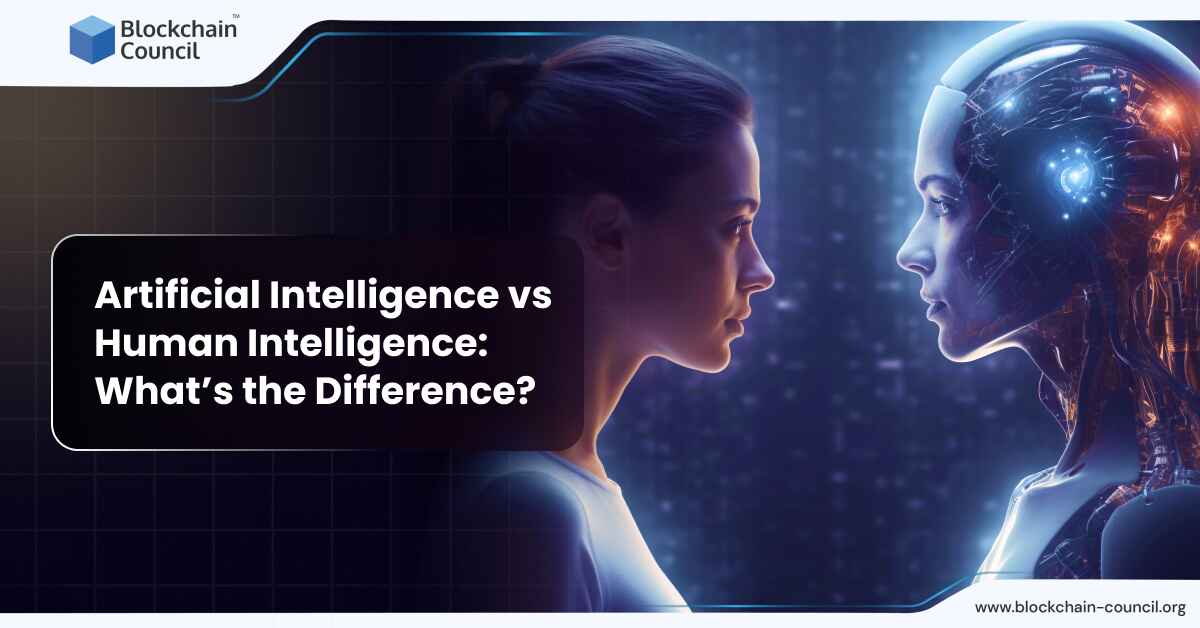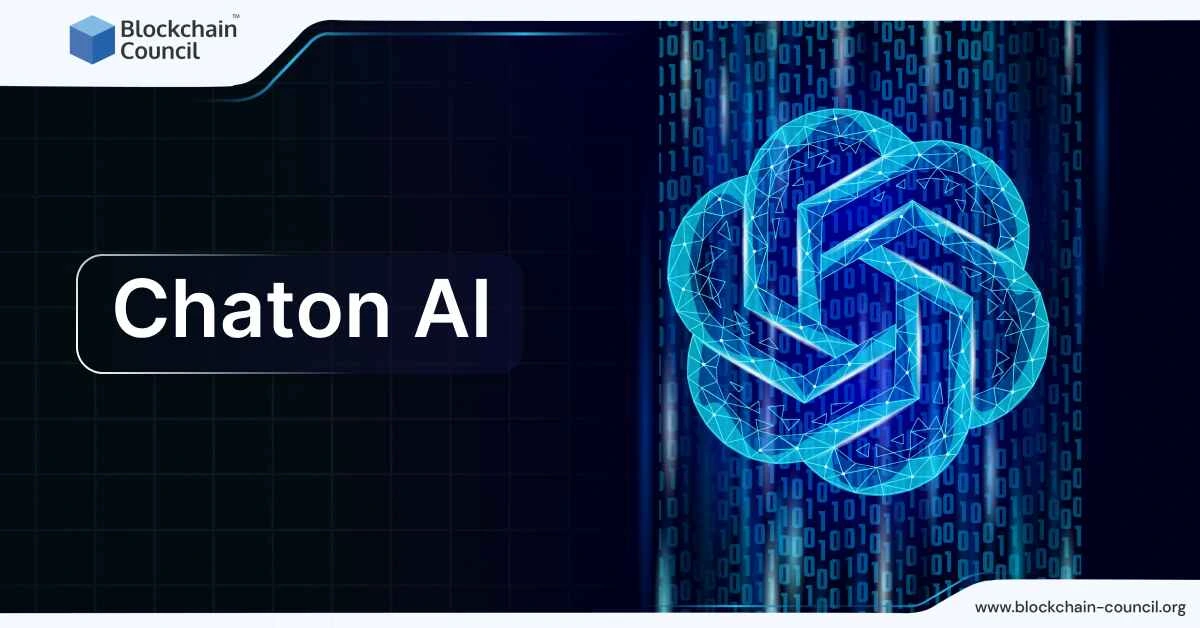
- Blockchain Council
- September 13, 2024
In the dawn of the 21st century, a new technological landscape is unfolding before us, marked by the unprecedented rise of Artificial Intelligence (AI). This era beckons us to explore the intricate and compelling comparison between AI and human intelligence. In this comprehensive exploration, we delve deep into the intricacies that differentiate Artificial Intelligence and Human Intelligence, while also highlighting areas where they intersect.
Historical Context and Evolution
Evolution of Human Intelligence
The journey of human intelligence is a remarkable story, deeply intertwined with our evolutionary path. The evolution of the human brain and intelligence began millions of years ago, significantly influenced by environmental changes and survival challenges.
Around 10 million years ago, climate shifts led to the transformation of dense forests into grasslands, particularly in Africa. This change in landscape was pivotal, pushing our primate ancestors from the trees to the ground. Here, they faced new predators and survival challenges, spurring the development of crucial evolutionary traits. Bipedalism, or walking on two legs, emerged as a key adaptation. It offered several advantages, such as a higher vantage point to spot dangers and the freeing up of hands for tool use and other tasks.
This period marked the beginnings of tool use among primates, which is evident in species like Sahelanthropus tchadensis, dating back to about 5 to 7 million years ago. The use of tools is a significant milestone in the evolution of human intelligence, requiring not just physical skill but also cognitive capabilities. Tools like stones and bones were used for various purposes, ranging from hunting to food processing.
As time progressed, the human brain evolved rapidly. There was a notable increase in brain volume, with Homo habilis having a brain volume of about 600 cm³, which further expanded in Homo neanderthalensis up to 1500 cm³. Interestingly, modern Homo sapiens have a slightly smaller brain volume (around 1250 cm³) compared to Neanderthals. This suggests that intelligence is not solely dependent on brain size but also on the complexity and efficiency of neural connections and brain structure..
The evolution of intelligence in humans is also marked by the development of sophisticated social behaviors and communication skills. The emergence of language and symbolic thought significantly contributed to our ancestors’ ability to collaborate, innovate, and transmit knowledge across generations, further accelerating the development of human intelligence.
History of Artificial Intelligence
The history of Artificial Intelligence (AI) is relatively recent compared to the millennia-spanning journey of human intelligence. AI’s roots can be traced back to the mid-20th century, with the development of the first programmable digital computers. These machines opened up possibilities for researchers to begin exploring computational approaches to intelligence.
One of the earliest instances of AI in action was the development of computer programs capable of playing chess and solving algebra problems. These early AI systems operated based on a set of predefined rules and logic, demonstrating the potential of machines to perform tasks requiring cognitive abilities.
Over the decades, AI has evolved significantly. The advent of machine learning and neural networks in the late 20th century marked a paradigm shift in AI development. These technologies enabled computers to learn from data and improve their performance over time, mirroring some aspects of human learning and intelligence.
Today, AI encompasses a wide range of technologies and applications, from voice recognition systems and intelligent personal assistants to sophisticated algorithms capable of analyzing large datasets and making predictions. The evolution of AI is characterized by rapid advancements in computational power, algorithmic complexity, and data availability, leading to increasingly sophisticated and capable AI systems.
Milestones in Both Domains
The milestones in the evolution of human and artificial intelligence highlight the distinct paths and mechanisms of development in these two domains.
In human intelligence, key milestones include the development of bipedalism, tool use, language, and symbolic thought. Each of these represents a significant leap in cognitive and social capabilities, enabling our ancestors to adapt, survive, and thrive in changing environments.
In contrast, milestones in AI development are closely tied to technological advancements and theoretical breakthroughs. Early achievements include the creation of rule-based systems and the Turing Test, proposed by Alan Turing as a measure of machine intelligence. The development of machine learning algorithms, the rise of neural networks, and the application of AI in diverse fields such as healthcare, finance, and autonomous vehicles represent significant milestones in AI evolution.
These milestones in both human and artificial intelligence underscore the complexity and diversity of intelligence as a concept. While human intelligence evolved as a result of biological, environmental, and social factors over millions of years, artificial intelligence is a product of human ingenuity and technological progress, evolving rapidly over just a few decades.
The Nature of Human Intelligence
Biological Basis of Human Intelligence
Human intelligence, a complex trait, stems from the intricate interactions of various brain regions. The Parieto-frontal Integration Theory suggests that the effectiveness of human intelligence is largely dependent on how well the frontal and parietal brain areas communicate and exchange information. This theory, supported by numerous neuroimaging studies, posits that these interconnections are crucial for intelligence differences among individuals.
Cognitive Abilities and Emotional Intelligence
Cognitive development theories, such as those proposed by Piaget and expanded by Neo-Piagetian theorists, emphasize the importance of mental models in understanding the world. These theories highlight that cognitive development in humans goes through various stages, each characterized by increasingly sophisticated mental models and cognitive abilities. Additionally, emotional intelligence, which encompasses the management of emotions and social interactions, plays a vital role in overall human intelligence.
Creativity and Abstract Thinking
Human intelligence is not just about processing information; it’s also deeply linked with creativity and abstract thinking. These aspects allow humans to conceptualize ideas, imagine scenarios beyond immediate reality, and engage in complex problem-solving. This creative and abstract dimension is a distinguishing feature of human intelligence, enabling innovations and artistic expressions.
Learning and Adaptability
Central to human intelligence is the ability to learn from experiences and adapt to changing environments. This adaptability is a multifaceted process, involving not just cognitive skills but also motivational, social, and behavioral aspects. Albert Bandura’s theory of self-efficacy highlights the importance of believing in one’s capabilities to effectively apply knowledge and skills, especially in challenging situations. This adaptability and learning capacity enable humans to navigate complex and dynamic environments successfully.
The exploration of human intelligence reveals a multifaceted construct that extends beyond mere cognitive processing. It involves emotional intelligence, creativity, and the ability to learn and adapt, all rooted in the biological complexity of the human brain.
Understanding Artificial Intelligence
Types of AI: Narrow AI vs General AI
Artificial Intelligence (AI) has evolved into distinct types, primarily categorized into Narrow AI and General AI. Narrow AI, also known as Weak AI, is specialized in handling specific tasks. It’s the form of AI that is prevalent in today’s technology, evident in applications like image recognition, language translation, and virtual assistants like Siri and Alexa. These systems are highly efficient within their domain but lack the broader cognitive abilities to perform tasks outside their programming. General AI, on the other hand, is an aspirational concept yet to be achieved. It refers to machines that could perform any intellectual task that a human can, characterized by the ability to generalize knowledge across various domains and adapt autonomously to new challenges.
How AI Works: Algorithms, Machine Learning, and Neural Networks
AI operates on complex algorithms, which are sets of rules and instructions for solving problems and performing tasks. Central to AI’s functionality are Machine Learning (ML) and Neural Networks. Machine Learning is a subset of AI where machines learn from data, identifying patterns, and making decisions with minimal human intervention. Neural Networks, inspired by the human brain, consist of layers of interconnected nodes that process data, enabling the system to learn from experience and improve over time.
AI’s Abilities: Pattern Recognition, Problem-Solving, and More
AI excels in several areas, particularly in pattern recognition, problem-solving, and automating routine tasks. For example, AI systems can analyze vast amounts of data to recognize trends in consumer behavior or detect anomalies in medical imaging. In problem-solving, AI can process and analyze data faster than humans, leading to quicker and more efficient decision-making. AI’s capability extends to various industries, streamlining processes, enhancing customer experiences, and driving innovation.
Limitations of AI
Despite its advancements, AI has limitations. The most significant is the lack of true cognitive and emotional understanding, which humans naturally possess. AI systems, especially Narrow AI, are confined to the parameters set by their programming and training data, which can lead to challenges in adapting to new or unforeseen scenarios. Furthermore, ethical considerations, such as privacy, security, and the potential for bias, are critical issues that need addressing as AI continues to integrate into society.
Comparing AI and Human Intelligence
Cognitive Processing: Speed and Efficiency
AI’s strength lies in its exceptional speed and efficiency in cognitive processing. It can analyze and process large volumes of data rapidly, far exceeding the capability of the human brain in tasks like image and speech recognition, and even outperforming humans in some areas since 2015. However, humans possess a unique blend of creativity and intuition, often outmaneuvering AI’s computational force with innovative strategies and a deep understanding of contexts.
Learning and Adaptation: Algorithms vs Experience
AI’s learning process, particularly in neural networks, is based on modifying synaptic connections to reduce error. This contrasts with human learning, which involves a more holistic approach, balancing neuron activities before adjusting synaptic connections, thus preserving existing knowledge and speeding up learning. AI has made strides in transfer learning, using knowledge from one area in another, but humans still excel in adapting behavior and thinking to new information or situations, generating creative ideas, and forming logical judgments.
Creativity and Innovation
In creativity, AI can generate art and music with algorithmic precision, but it lacks the emotional depth and intuitive grasp that human creativity offers. Humans infuse their works with personal experiences and emotions, which AI struggles to replicate. While AI can mimic the notes in music or the style in art, it cannot embody the soul and emotional depth that human creativity brings.
Emotional Intelligence and Empathy
Human intelligence stands apart in its ability to understand and manage emotions. AI, despite its advancements, lacks genuine emotional intelligence and empathy. Humans interpret and respond to emotional cues, an aspect that AI cannot authentically replicate. The emotional and social intelligence of humans plays a crucial role in decision-making and interpersonal interactions, an area where AI still has significant limitations.
Ethical and Moral Reasoning
Ethical and moral reasoning is a domain inherently human. While AI can follow programmed ethical guidelines, it does not possess the inherent moral compass and judgment that humans have developed through culture, society, and personal experiences. The ethical implications of AI’s decisions and actions, especially in scenarios involving complex moral dilemmas, remain a significant challenge and a domain where human intelligence distinctly excels.
Synergy and Collaboration
AI Enhancing Human Capabilities
Artificial Intelligence (AI) has significantly advanced human capabilities in various sectors. In the realm of cognitive enhancement, AI can extend human capacities, enabling people to behave in artificially intelligent ways. This extends beyond mere augmentation of human workers. AI now aids in improving personal and team capabilities, fostering new behaviors and helping workers evolve into better versions of themselves.
AI’s influence in learning and education is transformative, with adaptive learning systems personalizing educational content to an individual’s style and pace, thereby boosting engagement and retention. Furthermore, AI has contributed to risk reduction in hazardous occupations and augmented human creativity by providing tools that assist in creative endeavors like music, art, or writing, inspiring new heights of creativity.
Human Oversight in AI Development
Human oversight plays a pivotal role in the development and implementation of AI technologies. As AI systems become more integrated into various domains, it’s crucial to maintain a balance between technological advancements and human judgment. Concerns such as ethical decision-making, privacy, and potential job displacement due to automation require careful consideration and human guidance. The collaborative nature of AI systems and human-computer interaction is fundamental, as these systems are designed to work alongside humans, enhancing their capabilities and leading to better outcomes.
Collaborative Efforts in Various Fields
AI has revolutionized collaboration across multiple fields. In the workplace, AI technologies enhance human skills in decision-making with data-driven insights, helping employees make informed decisions swiftly. AI-driven tools in communication and project management streamline workflows and improve team collaboration. The impact of AI on project management is substantial, with AI-driven project management expected to make processes more efficient, shorten project durations, and reduce errors.
The Future of Human Intelligence in an AI-Dominated World
Preparing for a Future with Advanced AI
In the rapidly evolving landscape of Artificial Intelligence (AI), the future of human intelligence is poised at an intriguing crossroads. As we progress into an AI-dominated era, it is imperative to understand and prepare for the implications and opportunities this technological revolution presents.
- Adaptation and Co-evolution: The rise of advanced AI systems heralds a new era where human intelligence must adapt and co-evolve. The integration of AI into various aspects of life and work necessitates that humans develop new skills and adapt existing ones to maintain relevance and efficiency in a technology-driven world.
- Enhanced Cognitive Capabilities: AI’s potential to enhance cognitive capabilities is significant. From augmenting memory and processing speeds to providing analytical support, AI can amplify human intelligence in ways previously unimagined, opening new horizons for intellectual and creative pursuits.
- Synergistic Collaboration: The future lies not in competition, but in the synergistic collaboration between AI and human intelligence. This partnership can lead to groundbreaking advancements, with AI providing data-driven insights and humans contributing nuanced understanding and ethical considerations.
The Role of Education and Policy
The evolution of AI brings forth the need for strategic changes in education and policy-making.
- Revamping Education Systems: To prepare future generations for an AI-centric world, education systems need to be revamped. This involves incorporating AI literacy, digital skills, and a focus on STEM (Science, Technology, Engineering, and Mathematics) education from early stages.
- Lifelong Learning and Upskilling: In the face of AI advancements, lifelong learning and upskilling become essential. Professionals must continuously update their knowledge and skills to stay relevant. In this regard, certifications like those offered by the Blockchain Council play a crucial role. These certifications provide up-to-date knowledge and skills in AI and related technologies, ensuring individuals are equipped to thrive in an AI-driven environment.
- Policy Development and Ethical Guidelines: Governments and regulatory bodies need to develop policies and ethical guidelines to govern AI development and usage. This includes addressing issues like privacy, bias, and job displacement, ensuring AI advancements contribute positively to society.
- Promoting AI Research and Development: Investing in AI research and development is key to harnessing its full potential. This not only involves funding but also creating ecosystems where academia, industry, and government can collaborate to innovate and find solutions to complex challenges.
- Ethical AI and Human-Centric Approach: As AI becomes more advanced, a human-centric approach is vital to ensure AI systems are ethical, transparent, and accountable. This includes considerations around AI’s impact on society, jobs, and human well-being.
Conclusion
In the ongoing debate of Artificial Intelligence vs. Human Intelligence, it’s essential to recognize that both have unique strengths and limitations. AI excels in processing data, pattern recognition, and automation, while human intelligence brings emotional understanding, creativity, common sense, and consciousness to the table. Rather than framing this as a competition, the future lies in harnessing the strengths of both AI and HI, fostering collaboration that can drive innovation and address complex challenges in an increasingly digital world. Understanding the differences and intersections between these two forms of intelligence is not only a fascinating intellectual pursuit but also a vital step in shaping the future of technology and society.
Frequently Asked Questions
What is the key difference between human intelligence and artificial intelligence (AI)?
- Human intelligence is the result of millions of years of biological evolution, encompassing cognitive abilities, emotional intelligence, creativity, and adaptability.
- Artificial Intelligence (AI) is a product of recent technological advancements and relies on algorithms, machine learning, and neural networks to perform tasks, excelling in areas like pattern recognition and problem-solving.
- Human intelligence has a deep understanding of emotions, context, and ethical reasoning, whereas AI lacks emotional understanding and ethical judgment.
- While AI is highly efficient in processing data and automating tasks, human intelligence is characterized by creativity, intuition, and adaptability.
What are the limitations of artificial intelligence (AI)?
- One major limitation of AI is the lack of true emotional understanding and empathy, which humans naturally possess.
- AI systems, especially Narrow AI, are confined to their programming and training data, making it challenging to adapt to new or unforeseen scenarios.
- Ethical considerations, such as privacy, bias, and the potential for job displacement, are significant issues that need addressing as AI continues to integrate into society.
- AI is limited in creativity compared to human intelligence, as it struggles to replicate the emotional depth and intuitive grasp that humans bring to creative endeavors.
How can human intelligence and AI collaborate effectively?
- Effective collaboration between human intelligence and AI involves recognizing the strengths and limitations of both.
- AI can enhance human capabilities by providing data-driven insights, automating routine tasks, and aiding in decision-making.
- In fields like education, AI can personalize learning experiences and boost engagement, while in creative endeavors, it can provide tools that assist in music, art, or writing.
- Human oversight is crucial in AI development to ensure ethical decision-making, privacy protection, and addressing potential biases, as AI systems are designed to work alongside humans.
What steps should be taken to prepare for the future of human intelligence in an AI-dominated world?
- Revamping education systems to include AI literacy, digital skills, and a focus on STEM education from early stages is essential to prepare future generations.
- Lifelong learning and upskilling are crucial as professionals need to continuously update their knowledge and skills to stay relevant in an AI-centric world.
- AI certifications by the Blockchain Council can help your career reach new heights.
- Governments and regulatory bodies should develop policies and ethical guidelines to govern AI development and usage, addressing issues like privacy, bias, and job displacement.
- Investing in AI research and development and adopting a human-centric approach in AI development are key to harnessing its full potential and ensuring it positively contributes to society.





































































 Guides
Guides News
News Blockchain
Blockchain Cryptocurrency
& Digital Assets
Cryptocurrency
& Digital Assets Web3
Web3 Metaverse & NFTs
Metaverse & NFTs
